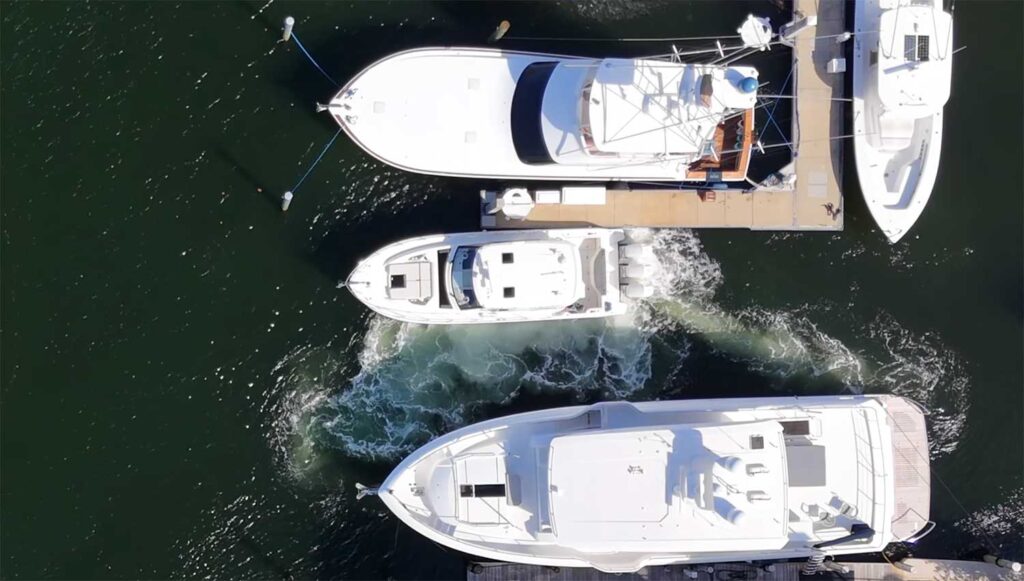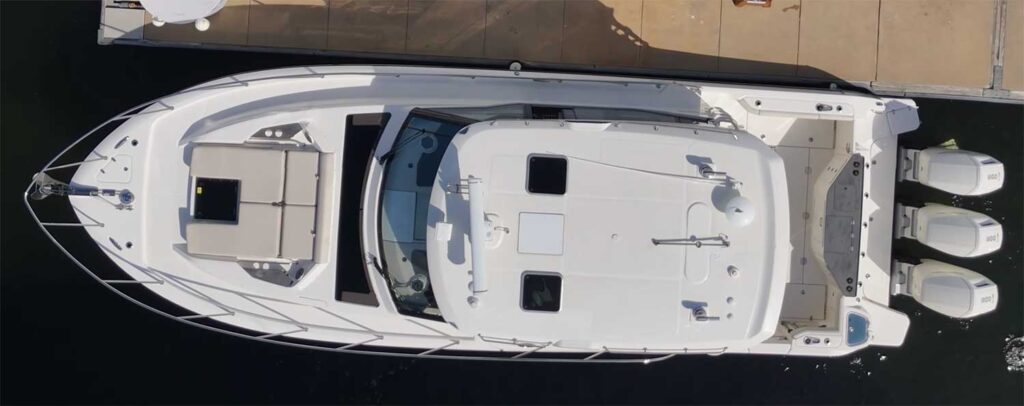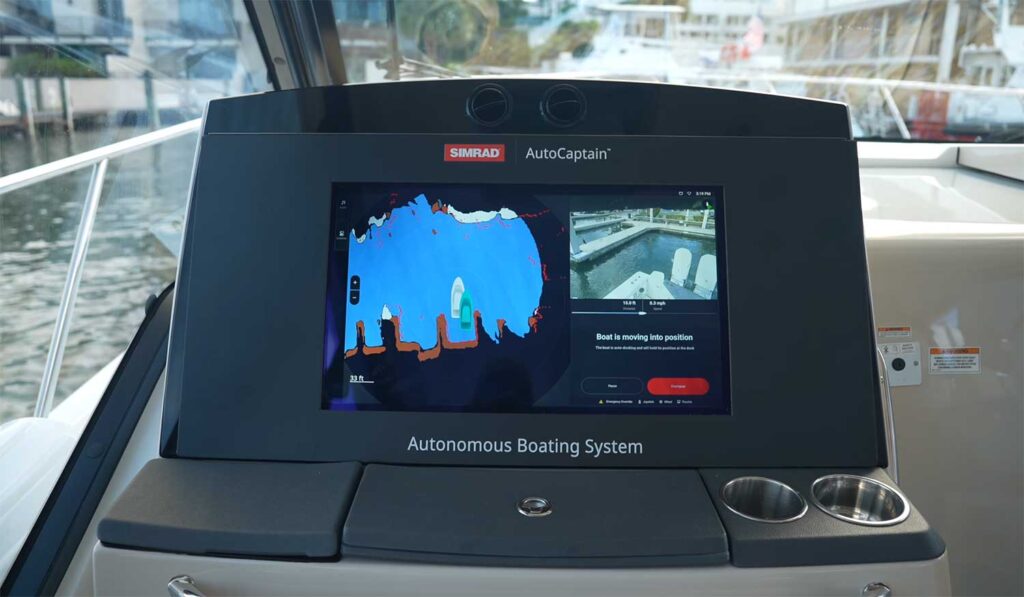Docking in close quarters during adverse conditions can sometimes be challenging, even for seasoned boaters. Crosswinds and crosscurrents, surrounded by mega superyachts and weekend warriors – navigating in these typical South Florida conditions can sometimes be daunting. Add the pressure of docking a six- or seven-figure vessel, and it can take the fun out of boating.
At this year’s Fort Lauderdale International Boat Show (FLIBS) -the world’s largest in-water boat show, attracting over 100,000 visitors – a Boston Whaler is doing its best impersonation of a Tesla. With just a touch of a screen, this Boston Whaler can parallel park your boat.
Making a splash at this year’s boat show is Simrad’s new AutoCaptain autonomous boating system. It’s a true game changer in the boating world in every sense. It’s the culmination of years of research and development that marries the smarts of Artificial Intelligence (AI) with a myriad of marine sensors and Mercury’s Joystick Piloting for the Outboards (JPO).
With just a few taps on the screen, AutoCaptain takes over control and glides into your boat slip. It liberates you from the stress during close-quarters maneuvering at docking and lets you enjoy your time on the water.
Test Boat
Simrad’s new AutoCaptain system was available for all to see and experience at this year’s FLIBS. Their test boat was a 40-foot Boston Whaler 405 Conquest with triple Mercury V12, 600-hp Verados. Currently, the new AutoCaptain system is only compatible with Mercury Marine (another Brunswick subsidiary) outboards and sterndrives.
The test boat successfully docked numerous times during the show in various changing and challenging conditions. Below is a video of the test boat:
Under the Hood
AutoCaptain uses Artificial Intelligence (AI) and software to choreograph the interplay of all the boat’s advanced hardware. All the boat’s environmental data (position, movement, radar targets, sonar targets, and slip position) is continually streamed into the AI brain of the system, which outputs precise adjustments to the boat’s propulsion and steering systems.
The system draws from a 360-degree suite of sensors, including high-resolution cameras, radar arrays, and sonar transducers. All these sensors are used to piece together a detailed mosaic of the boat’s physical environment. Cameras detect dock edges, radar detects other vessels – both those docked and passing through- and underwater sonar images detect obstacles and structures, such as seawalls and pilings. GPS data also reveals the presence of crosswinds and crosscurrents that affect positioning. The system is continually adjusting based on all these environmental inputs. The end result is the boat gliding seemingly effortlessly into its slip.
The AI brain of this dance uses machine learning algorithms trained on millions of simulated docking scenarios. The system’s AI component predicts and reacts faster than any human can. Additionally, the AI will continue to evolve as it learns from more real-world experiences shared among all other AutoCaptain installations.
How it Works
Simrad’s NSX-series multifunction displays are networked with Mercury’s VesselView and Joystick Piloting. To dock using the Simrad display, drag your boat’s icon to the desired spot on the screen and select “Engage.” AutoCaptain takes over all maneuvering tasks, and you can monitor progress on the screen. Once docked, AutoCaptain will hold your position as long as necessary for you to secure the vessel. Leaving the dock is the same process in reverse sequence.

Step-by-Step How To
Below is the sequence as demonstrated aboard the Boston Whaler 405 Conquest at the FLIBS (video above):
Approach & Scan
Slow to 3 knots or less when you are 50–100 feet from the marina. AutoCaptain activates a 360° sensor sweep, featuring four 4K cameras, two radars, and forward and downward sonar. On-screen AutoCaptain renders a live 3D wireframe view of the dock, pilings, and any neighboring boats.
Select Berth
Tap, drag, and rotate the virtual boat icon on the screen to target your slip and final desired position. AI calculates possible paths and ranks them by clearance, wind drift, and current offset. AutoCaptain will display your optimal path as a green path, with alternate paths in yellow, and red paths indicating blocked or impossible routes.
Confirm & Engage
Select the “engage” option on the screen. The AutoCaptain system takes full propulsion and steering control; the engines drop to idle, the bow thruster (if equipped) engages, and your live trajectory is overlaid on the screen.
Lateral Translation
No user input is required, as the outboards fire automatically as your boat crab-walks towards the dock. Your real-time position is continually displayed on the screen, as well as a “ghost boat” indicating your predicted position 5 seconds into the future.
Final Alignment
No user input is required, as the sonar measures the exact distance to the dock to within centimeters. Final micro-thrusts of the engines and fine steering corrections rotate the bow as needed. A distance-to-dock counter counts down.
Soft Touch & Hold
Still, no user input needed. Engines pulse in minute fashion as they reduce closing speed and fenders kiss the dock. Dynamic positioning utilizes GPS to maintain your position to within 10 cm. Status: docked and holding station. On screen, a green checkmark confirms docking was successful.
Disengage
Tap “disengage” to return controls to the helm after you have secured your vessel. Screens return to standard VesselView.
Done in 60 seconds.

Notable Limitations
The AutoCaptain system is really not fully autonomous. It requires user input to engage – and like a Tesla, it requires the captain’s attention during docking. The captain must remain ready to take control at any time during the docking sequence. This is especially true while docking during adverse conditions. The system is actually designed to stop working if conditions become too hazardous – such as winds exceeding 20 knots.
Final Thoughts
According to Coast Guard statistics, operator error accounts for up to 70% of incidents. And the highest risk phase of boating is during docking. Docking mishaps contribute to thousands of annual claims. This technology makes boating safer. Insurance companies are likely to take notice and ultimately offer discounts for using this technology.
This technology also promises to make boating more inclusive and accessible. Boats are becoming larger, and their operators are aging. The average U.S. boater is 54 years old. Older boaters are the ones most likely to have the deeper pockets needed to acquire these ever-larger vessels. Regardless of age, larger boats come with a steeper learning curve. AutoCaptain can help lessen the anxiety and provide support as first-time captains learn the ropes.



